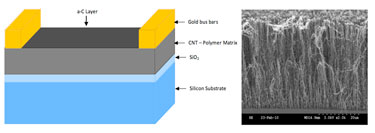Multi-walled carbon nanotubes (MWCNTs) have been widely reported as effective and highly sensitive che-mical and biological sensors. However, imparting selectivity to these sensors has been a major challenge. Reporting their results in the journal Nanotechnology, researchers based at the University of Kentucky,U-S, have come up with a fabrication scheme that offers good control over the sensitivity of the device and m-akes the composite films gas-specific. The team has used the approach to develop composite films of MW-CNTs and conducting polymers, which can selectively detect reducing and oxidizing agents even at low co-ncentrations.

Resistive sensor design for selective gas detection
First, the group grows MWCNT arrays on thin layers of silicon dioxide grown on top of silicon substrates. T-hese are then incorporated into hybrid sensor devices after functionalizing them with various conducting p-olymers.
Crucial by-product
The nanotubes were fabricated by a CVD process, during which a thin amorphous carbon (a-C) layer form-ed on the surface of MWCNTs. The team used a plasma etch technique to not only tailor the a-C layer thic-kness, but also create additional active sites for the bonding of functional groups. A simple solvent modific-ation of the polymer resulted in a gas selective response from the nanocomposite sensors.
FTIR characterization results revealed that the conducting polymers are covalently bonded with the nanot-ube surface and are responsible for obtaining selectivity and enhanced sensitivities.
Simple method
Even though there are several reports on the fabrication of CNT–polym-er nano-composite films and solve-nt effects on polymer conductivity, this work presents a uniquely simple method for fabricating CNT–polymer nanocomposites and integrating them into sensor devices that exhibit selectivity to analyte gases.
The fabrication technique allows for a wide range of control over device sensitivity and selectivity, thus co-nstituting an important step toward the commercialization of CNT-based sensor technologies.
The group is now investigating new MWNT-polymer-solvent combinations and compositions for further imp-rovements in sensitivity, detectability and selectivity.
Full details can be found in the journal Nanotechnology.

